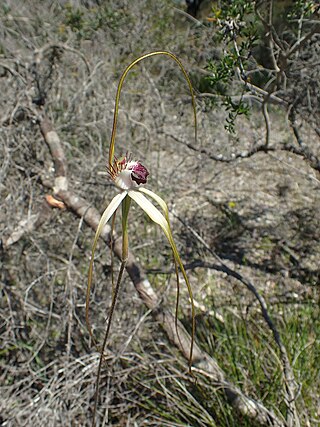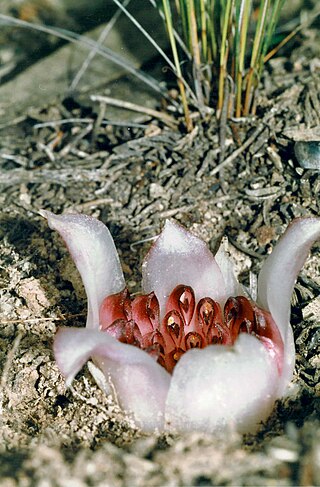
Rhizanthella slateri, commonly known as the eastern underground orchid, is a species of flowering plant in the orchid family and is endemic to New South Wales. It is a mycoheterotrophic herb that spends most of its life under the soil surface, its flowers only sometimes appearing a few millimetres about ground level.

Babakin is a small town located in the Wheatbelt region of Western Australia between the towns of Bruce Rock and Corrigin. At the 2021 census the population of Babakin was 56. Facilities in the town include a school, shop, hall and sporting facilities.

Rhizanthella, commonly known as underground orchids, is a genus of flowering plants in the orchid family, Orchidaceae and is endemic to Australia. All are leafless, living underground in symbiosis with mycorrhizal fungi. The inflorescence is a head of flowers held at, or just above the ground but mostly covered by soil or leaf litter and little is known about the mechanism of pollination.

Grevillea scapigera, commonly known as Corrigin grevillea, is a species of flowering plant in the family Proteaceae and is endemic to a small area of the south-west of Western Australia. It is a prostrate to weakly ascending, suckering shrub with divided leaves, the end lobes broadly triangular and sharply-pointed, and spikes of white to cream-coloured flowers held above the foliage.

Melaleuca uncinata, commonly known as broombush, broom honeymyrtle or brushwood, is a plant in the paperbark family native to southern Australia. It is harvested from the wild, and grown in plantations, for broombush fencing. The Noongar names for the plant are kwytyat and yilbarra.

Caladenia arenicola, commonly known as the carousel spider orchid, is a plant in the orchid family Orchidaceae and is endemic to the south-west of Western Australia. It has a single erect, hairy leaf and up to three red, white and green flowers on a flowering stem up to 60 cm (20 in) high. It is a common species on the Swan Coastal Plain, where it grows in sandy soil under trees.

Caladenia arrecta, commonly known as the reaching spider orchid, is a plant in the orchid family Orchidaceae and is endemic to the south-west of Western Australia. It has a single erect, hairy leaf and up to three red, yellow and green flowers on a flowering stem up to 35 cm (10 in) high. It is distinguished from the similar C. longiclavata and C. magniclavata by its upswept petals and distinctive calli. Although not common, it is widespread in south-eastern coastal areas.
Caladenia bicalliata is a species of flowering plant in the orchid family Orchidaceae and is native to the south-west of Western Australia and coastal areas of South Australia. It has a single erect, hairy leaf and one or two cream-coloured flowers. There are two subspecies differing in the size and colour of the flowers.
Caladenia citrina, commonly known as the Margaret River spider orchid, is a plant in the orchid family Orchidaceae and is endemic to the south-west of Western Australia. It has a single erect, hairy leaf and up to three lemon-yellow flowers. It has a narrow distribution in the far south-west corner of Western Australia.

Caladenia excelsa, commonly known as the giant spider orchid, is a species of orchid endemic to a small area in the south-west of Western Australia. It is a rare species with a single, hairy leaf and up to three cream-coloured to greenish-cream flowers with long, drooping sepals and petals. It is one of the tallest spider orchids in Western Australia and, with Caladenia splendens, has the largest flowers of any Western Australian orchid.

Caladenia fluvialis, commonly known as the Brookton Highway spider orchid is a species of orchid endemic to the south-west of Western Australia. It is a recently discovered orchid with a single hairy leaf and one or two cream-yellow flowers with red markings on the labellum.
Caladenia hiemalis, commonly known as the dwarf common spider orchid is a species of orchid endemic to the south-west of Western Australia. It has a single, hairy leaf and one or two, cream-coloured flowers with a small, red-striped labellum. It has an early flowering period and its flowering is stimulated by summer fires.

Caladenia huegelii, commonly known as the grand spider orchid is a species of orchid endemic to the south-west of Western Australia. It has a single, hairy leaf and up to three relatively large red, green and cream-coloured flowers which have "split-hairs" on the sides of the labellum.

Caladenia radialis, commonly known as the drooping spider orchid, is a species of orchid endemic to the south-west of Western Australia. It has a single erect, hairy leaf and one or two red and cream-coloured flowers. In good seasons it forms clumps of up to ten plants.
Caladenia petrensis, commonly known as the rock spider orchid is a plant in the orchid family Orchidaceae and is endemic to the south-west of Western Australia. It has a single erect, hairy leaf and up to three pale yellow flowers with drooping lateral sepals and petals.

Caladenia vulgata, commonly known as the common spider orchid, is a species of orchid endemic to the south-west of Western Australia. It is a relatively common and widespread orchid with a single erect, hairy leaf and up to three creamy-white flowers. There is some variation in the species, both in flower colour and growth habit.
Pterostylis brunneola, commonly known as the giant snail orchid, is a species of orchid endemic to the south-west of Western Australia. Both flowering and non-flowering plants have a large rosette of leaves flat on the ground and flowering plants have a single distinctive white flower with pale fawn stripes and have leaves on the flowering spike. This species often forms large colonies, sometimes with Caladenia species.
Rhizanthella speciosa is a species of flowering plant in the orchid family and is endemic to Barrington Tops in New South Wales. It is a mycoheterotrophic herb that spends its entire life cycle, including flowering, at or below the soil surface. As at September 2020, R. speciosa has not yet been accepted as a valid name by the World Checklist of Selected Plant Families or the Australian Plant Census.

Rhizanthella johnstonii, commonly known as south coast underground orchid, is a species of flowering plant in the orchid family and is endemic to the southwest of Western Australia. It is a subterranean herb that has a horizontal rhizome and a head of up to sixty small white flowers with a pink tinge, surrounded by relatively large, cream-coloured to pale pinkish cream bracts.
Rhizanthella omissa is a species of flowering plant in the orchid family and is found in the Lamington National Park in Queensland. It is a subterranean herb that grows in casuarina forest and flowers underground. It was first formally described in 2006 by David Jones and Mark Clements in the journal The Orchadian. The species is listed as "endangered" under the Queensland Government Nature Conservation Act 1992.














